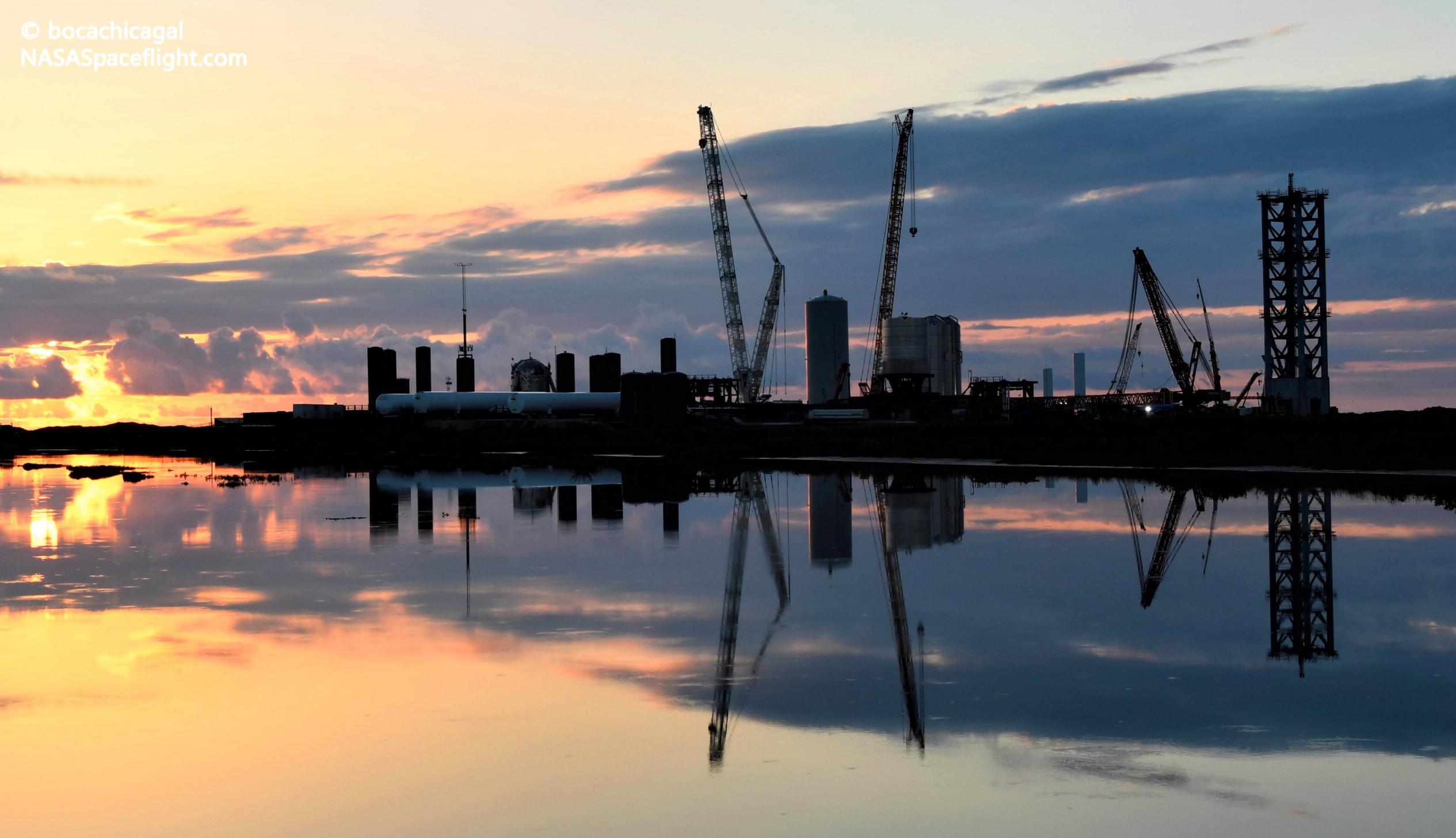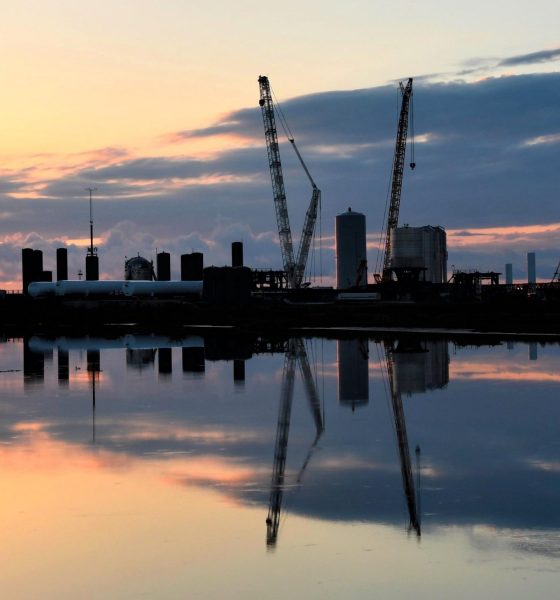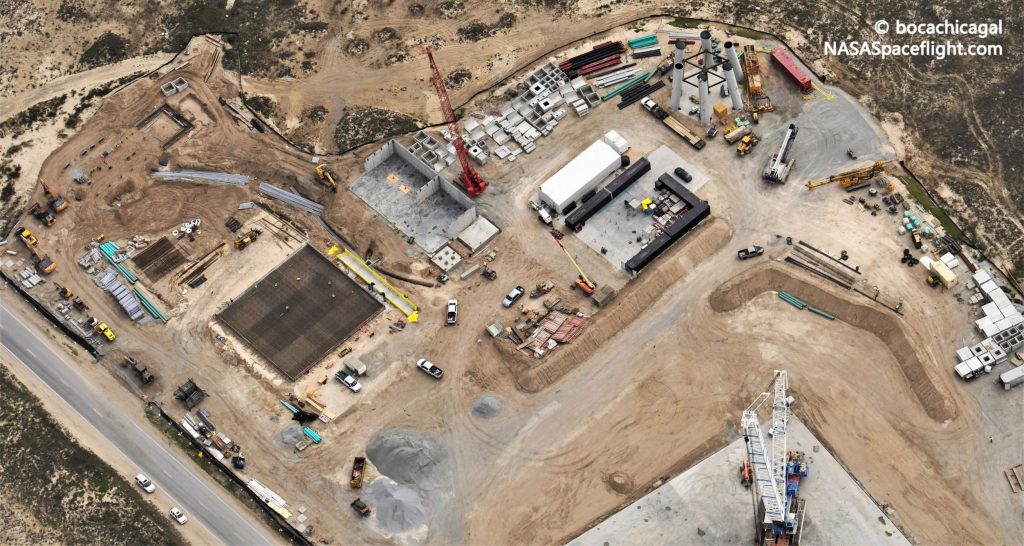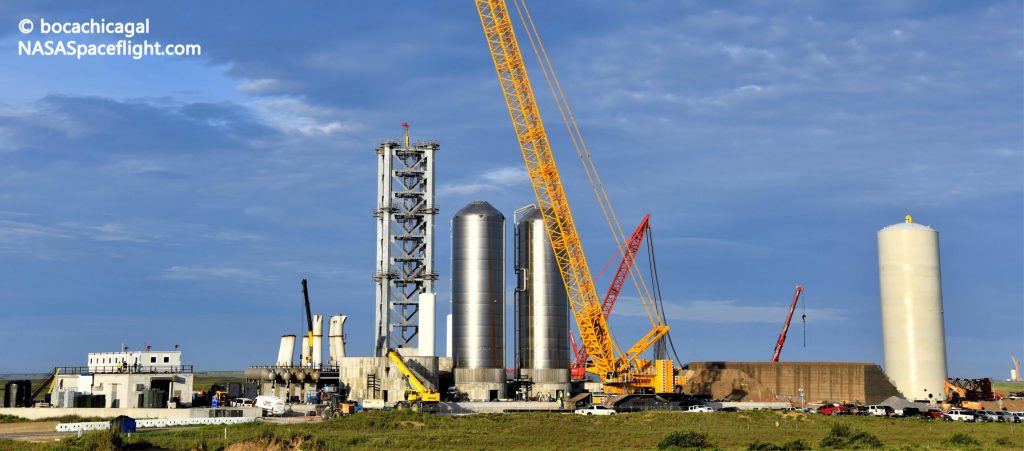

News
SpaceX rolls Starship launch tower section, giant water tank to orbital pad
After a brief pause, SpaceX is once again shipping pad hardware from its Boca Chica, Texas rocket factory to Starship’s rapidly growing orbital launch site (OLS).
A few days of delays aside, the latest transport simultaneously rolled a massive 12m (40 ft) wide water tank and another prefabricated section of SpaceX’s skyscraper-sized orbital launch tower to a nascent orbital launch site adjacent to two well-worn suborbital pads.
Those suborbital pads have been through dozens of ground tests of Starship test tanks, hoppers, and high-altitude prototypes over the last ~20 months, recently culminating in Starship SN15 launching to 10 km (6.2 mi), free-falling back to earth, and becoming the first prototype of its kind to successfully touch down. Since that May 5th milestone, Starship SN15 has been moved to an empty lot – likely to be put permanently on display – and SpaceX’s focus has quite clearly shifted towards Starship’s first orbital test flights.
To even be able to attempt those test flights, which will involve a Starship installed on top of the world’s most powerful rocket booster, several things must be in order. Relative to the three-engine, medium-altitude Starship prototypes SpaceX has the most experience with, CEO Elon Musk has implied that even the very first flightworthy Super Heavy boosters will be outfitted with 29 Raptor engines, representing an almost order-of-magnitude leap in lift-off thrust. In other words, SpaceX’s proven suborbital launch mounts are wholly inadequate for even a rudimentary orbital launch attempt.
Aside from being unable to withstand the immense stress of at least ~5800 metric tons (12.8 million lbf) of thrust, SpaceX’s suborbital pad also has far too little propellant storage capacity to fuel an orbital launch attempt. Enter SpaceX’s first South Texas orbital launch site.

In response, SpaceX has been gradually building out brand new orbital-class launch facilities for around nine months. Work on the pad began to significantly accelerate earlier this year, including the delivery of Starship-derived propellant storage tanks, the rapid assembly of even larger insulation ‘sleeves’ for those custom tanks, the even faster construction of multiple prefabricated launch tower segments, finishing touches on a tall six-legged ‘launch mount,’ the completion of a massive cryogenic propellant pumphouse, miles of wire and pipe runs, and far more.

As it turns out, the second propellant storage tank ‘sleeve’ is actually a massive water tank, indicating that Starship’s first orbital launch site will have some form of water deluge system to limit the damage Super Heavy’s 29 Raptors can do to the pad and rocket itself at liftoff. The tank measures 12m (40ft) wide and approximately 36m (~120ft) tall, meaning that it should be able to hold more than a million gallons (~4000 cubic meters) of water.
Additionally, SpaceX delivered the third prefabricated launch tower segment, leaving the tower more than half its full ~143m (469ft) height once installed. Two more sections are already more than half finished, likely meaning that the tower’s structural skeleton could be fully assembled by July or August.

News
Tesla FSD fleet is nearing 7 billion total miles, including 2.5 billion city miles
As can be seen on Tesla’s official FSD webpage, vehicles equipped with the system have now navigated over 6.99 billion miles.

Tesla’s Full Self-Driving (Supervised) fleet is closing in on almost 7 billion total miles driven, as per data posted by the company on its official FSD webpage.
These figures hint at the massive scale of data fueling Tesla’s rapid FSD improvements, which have been quite notable as of late.
FSD mileage milestones
As can be seen on Tesla’s official FSD webpage, vehicles equipped with the system have now navigated over 6.99 billion miles. Tesla owner and avid FSD tester Whole Mars Catalog also shared a screenshot indicating that from the nearly 7 billion miles traveled by the FSD fleet, more than 2.5 billion miles were driven inside cities.
City miles are particularly valuable for complex urban scenarios like unprotected turns, pedestrian interactions, and traffic lights. This is also the difference-maker for FSD, as only complex solutions, such as Waymo’s self-driving taxis, operate similarly on inner-city streets. And even then, incidents such as the San Francisco blackouts have proven challenging for sensor-rich vehicles like Waymos.
Tesla’s data edge
Tesla has a number of advantages in the autonomous vehicle sector, one of which is the size of its fleet and the number of vehicles training FSD on real-world roads. Tesla’s nearly 7 billion FSD miles then allow the company to roll out updates that make its vehicles behave like they are being driven by experienced drivers, even if they are operating on their own.
So notable are Tesla’s improvements to FSD that NVIDIA Director of Robotics Jim Fan, after experiencing FSD v14, noted that the system is the first AI that passes what he described as a “Physical Turing Test.”
“Despite knowing exactly how robot learning works, I still find it magical watching the steering wheel turn by itself. First it feels surreal, next it becomes routine. Then, like the smartphone, taking it away actively hurts. This is how humanity gets rewired and glued to god-like technologies,” Fan wrote in a post on X.
News
Tesla starts showing how FSD will change lives in Europe
Local officials tested the system on narrow country roads and were impressed by FSD’s smooth, human-like driving, with some calling the service a game-changer for everyday life in areas that are far from urban centers.

Tesla has launched Europe’s first public shuttle service using Full Self-Driving (Supervised) in the rural Eifelkreis Bitburg-Prüm region of Germany, demonstrating how the technology can restore independence and mobility for people who struggle with limited transport options.
Local officials tested the system on narrow country roads and were impressed by FSD’s smooth, human-like driving, with some calling the service a game-changer for everyday life in areas that are far from urban centers.
Officials see real impact on rural residents
Arzfeld Mayor Johannes Kuhl and District Administrator Andreas Kruppert personally tested the Tesla shuttle service. This allowed them to see just how well FSD navigated winding lanes and rural roads confidently. Kruppert said, “Autonomous driving sounds like science fiction to many, but we simply see here that it works totally well in rural regions too.” Kuhl, for his part, also noted that FSD “feels like a very experienced driver.”
The pilot complements the area’s “Citizen Bus” program, which provides on-demand rides for elderly residents who can no longer drive themselves. Tesla Europe shared a video of a demonstration of the service, highlighting how FSD gives people their freedom back, even in places where public transport is not as prevalent.
What the Ministry for Economic Affairs and Transport says
Rhineland-Palatinate’s Minister Daniela Schmitt supported the project, praising the collaboration that made this “first of its kind in Europe” possible. As per the ministry, the rural rollout for the service shows FSD’s potential beyond major cities, and it delivers tangible benefits like grocery runs, doctor visits, and social connections for isolated residents.
“Reliable and flexible mobility is especially vital in rural areas. With the launch of a shuttle service using self-driving vehicles (FSD supervised) by Tesla in the Eifelkreis Bitburg-Prüm, an innovative pilot project is now getting underway that complements local community bus services. It is the first project of its kind in Europe.
“The result is a real gain for rural mobility: greater accessibility, more flexibility and tangible benefits for everyday life. A strong signal for innovation, cooperation and future-oriented mobility beyond urban centers,” the ministry wrote in a LinkedIn post.
News
Tesla China quietly posts Robotaxi-related job listing
Tesla China is currently seeking a Low Voltage Electrical Engineer to work on circuit board design for the company’s autonomous vehicles.

Tesla has posted a new job listing in Shanghai explicitly tied to its Robotaxi program, fueling speculation that the company is preparing to launch its dedicated autonomous ride-hailing service in China.
As noted in the listing, Tesla China is currently seeking a Low Voltage Electrical Engineer to work on circuit board design for the company’s autonomous vehicles.
Robotaxi-specific role
The listing, which was shared on social media platform X by industry watcher @tslaming, suggested that Tesla China is looking to fill the role urgently. The job listing itself specifically mentions that the person hired for the role will be working on the Low Voltage Hardware team, which would design the circuit boards that would serve as the nervous system of the Robotaxi.
Key tasks for the role, as indicated in the job listing, include collaboration with PCB layout, firmware, mechanical, program management, and validation teams, among other responsibilities. The role is based in Shanghai.
China Robotaxi launch
China represents a massive potential market for robotaxis, with its dense urban centers and supportive policies in select cities. Tesla has limited permission to roll out FSD in the country, though despite this, its vehicles have been hailed as among the best in the market when it comes to autonomous features. So far, at least, it appears that China supports Tesla’s FSD and Robotaxi rollout.
This was hinted at in November, when Tesla brought the Cybercab to the 8th China International Import Expo (CIIE) in Shanghai, marking the first time that the autonomous two-seater was brought to the Asia-Pacific region. The vehicle, despite not having a release date in China, received a significant amount of interest among the event’s attendees.








